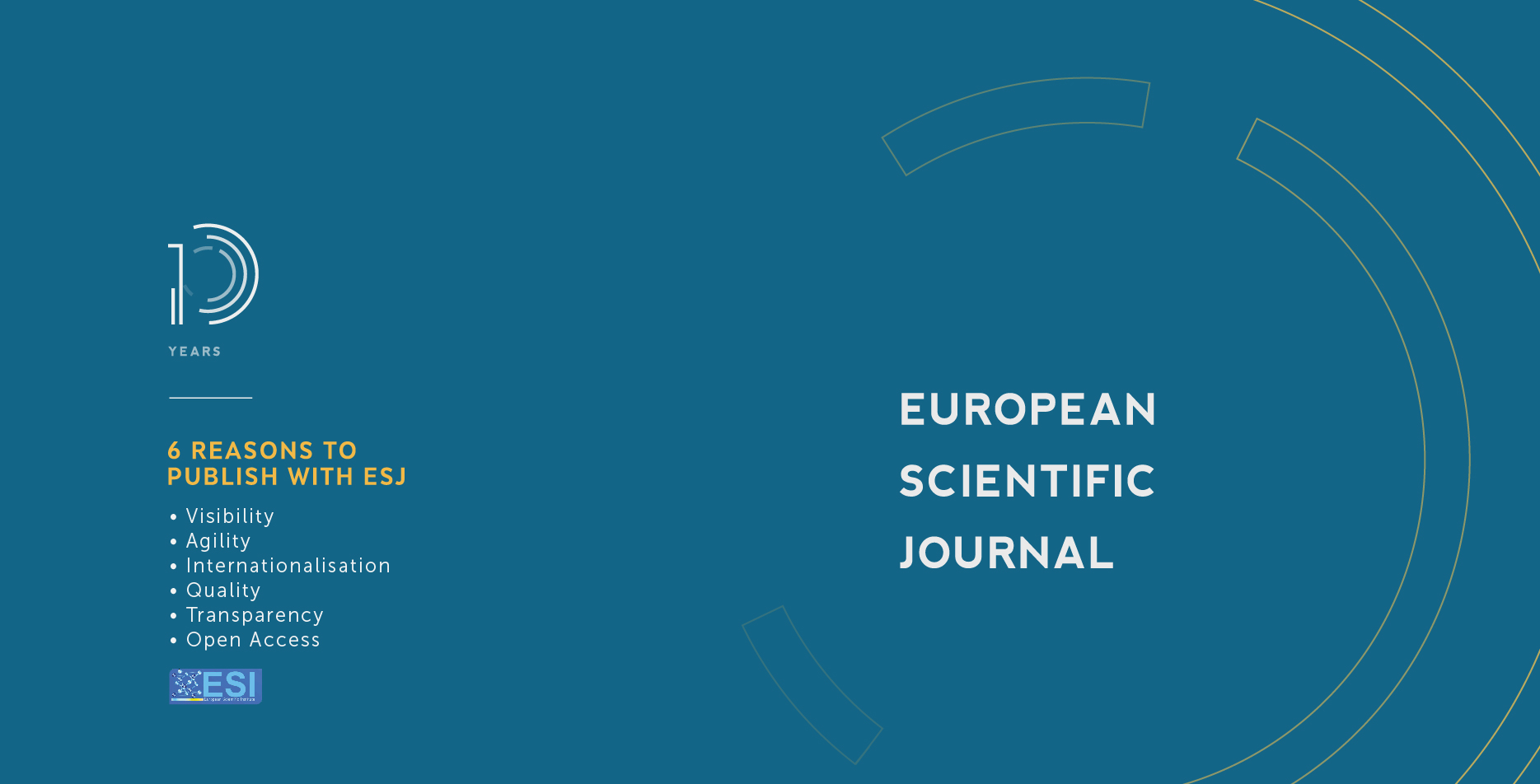Modelling and Optimizing the Removal of Methylene Blue by a Mixture of Titaniferous Sand and Attapulgite Using Complete Factorial Design
Abstract
This paper focuses on the removal of methylene blue by adsorption using a mixture of titaniferous sand and attapulgite. The different adsorbents were characterized by X-ray fluorescence spectroscopy and their different parameters such as pH, zero charge potential, and specific surface area were determined. The experiments performed were optimized and modeled by a full 2-level and 4-factor design. The four factors are the ratio of titaniferous sand and attapulgite, the concentration of methylene blue, pH, and time. These vary from 4 to 19, 20 to 100 mg/L, 2 to 9, and 30 to 150 min respectively. The study of the effects of the different factors showed that the effect of methylene blue concentration and pH significantly influence the adsorption capacity and removal efficiency of the dye. The optimum parameters (adsorbent ratio, adsorbate concentration, pH and time) obtained for the adsorption capacity through the desirability function are: 19, 100mg/L, 9 and 150min. Those obtained for the yield are: 4, 100mg/L, 9, 150min. The pseudo second order adsorption kinetics gave an equilibrium adsorption capacity qe (calculated) = 7.6863 mg/g which is almost equal to that obtained experimentally qe (exp) = 7.3562 mg/g. This shows that the pseudo second order kinetic model is the adequate mathematical model to describe the methylene blue adsorption phenomenon on the mixture of titaniferous sand and attapulgite. The thermodynamic study showed that the methylene blue adsorption reaction is exothermic, non-spontaneous, and the degree of disorder of the particles at the adsorbing surface decreases.
Downloads
Metrics
PlumX Statistics
References
2. Abbaz, M., Aba, R., El, R., Lhanafi, S. & El, N. (2014). Elimination du bleu de méthylène dans l’eau par adsorption sur le sable titanifère (Removal of methylene blue from aqueous solution by adsorption onto the sand titaniferous). 5, 2418–2425.
3. Benguella, B. & Yacouta-Nour, A. (2009). Elimination des colorants acides en solution aqueuse par la bentonite et le kaolin. Comptes Rendus Chimie, 12(6–7), 762–771.
4. Biophys, J. P. C., Aa, O. & Aj, O. (2014). Journal of Physical Chemistry & Kinetic Study of Decolorization of Methylene Blue with Sodium Sulphite in Aqueous Media : Influence of Transition Metal Ions. 4(2), 1–7.
5. Bonetto, L. R., Ferrarini, F., De Marco, C., Crespo, J. S., Guégan, R. & Giovanela, M. (2015). Removal of methyl violet 2B dye from aqueous solution using a magnetic composite as an adsorbent. Journal of Water Process Engineering, 6, 11–20.
6. Bhattacharyya, K. G. & Gupta, S. Sen. (2007). Adsorptive accumulation of Cd(II), Co(II), Cu(II).
7. Pb(II), and Ni(II) from water on montmorillonite: Influence of acid activation. Journal of Colloid and
8. Interface Science, 310(2), 411–424. https://doi.org/10.1016/j.jcis.2007.01.080
9. Chen, Xi, Li, P., Zeng, X., Kang, Y., Wang, J., Xie, H., Liu, Y. & Zhang, Y. (2020). Efficient adsorption of methylene blue by xanthan gum derivative modified hydroxyapatite. International Journal of Biological Macromolecules, 151, 1040–1048.
10. Chen, Xiaoyu, Song, X. & Sun, Y. (2016). with Core-Shell Structure for Dye Adsorption. 2016.
El-Sayed, G. O. (2011). Removal of methylene blue and crystal violet from aqueous solutions by palm kernel fiber. Desalination, 272(1–3), 225–232.
12. Gupt, C. B., Bordoloi, S., Sekharan, S. & Sarmah, A. K. (2020). Adsorption characteristics of Barmer bentonite for hazardous waste containment application. Journal of Hazardous Materials, 396(April), 122594.
13. Gürses, A., Doǧar, Ç., Yalçin, M., Açikyildiz, M., Bayrak, R. & Karaca, S. (2006). The adsorption kinetics of the cationic dye, methylene blue, onto clay. Journal of Hazardous Materials, 131(1–3), 217–228.
14. Jayasantha Kumari, H., Krishnamoorthy, P., Arumugam, T. K., Radhakrishnan, S. & Vasudevan, D. (2017). An efficient removal of crystal violet dye from waste water by adsorption onto TLAC/Chitosan composite: A novel low cost adsorbent. International Journal of Biological Macromolecules, 96, 324–333.
15. Karim, A. B., Mounir, B., Hachkar, M., Bakasse, M. & Yaacoubi, A. (2010). Removal of basic dye “methylene blue” in aqueous solution by Safi clay. Revue Des Sciences de l’Eau, 23(4), 375–388.
16. Kavak, D. (2009). Removal of boron from aqueous solutions by batch adsorption on calcined alunite using experimental design. Journal of Hazardous Materials, 163(1), 308–314.
17. Mekatel, E. H., Amokrane, S., Aid, A., Nibou, D. & Trari, M. (2015). Adsorption of methyl orange on nanoparticles of a synthetic zeolite NaA/CuO. Comptes Rendus Chimie, 18(3), 336–344.
18. Oladipo, A. A., Gazi, M. & Saber-Samandari, S. (2014). Adsorption of anthraquinone dye onto eco-friendly semi-IPN biocomposite hydrogel: Equilibrium isotherms, kinetic studies and optimization. Journal of the Taiwan Institute of Chemical Engineers, 45(2), 653–664.
19. Ozer, C., Imamoglu, M. & Turhan, Y. (2012). Toxicological & Environmental Chemistry Removal of methylene blue from aqueous solutions using phosphoric acid activated carbon produced from hazelnut husks. November 2014, 37–41.
20. Salehi, E., Askari, M., Velashjerdi, M. & Arab, B. (2020). Phosphoric acid-treated Spent Tea Residue Biochar for Wastewater Decoloring: Batch Adsorption Study and Process Intensification using Multivariate Data-based Optimization. Chemical Engineering and Processing - Process Intensification, 158(July), 108170.
21. Salem, I. A. & El-maazawi, M. S. (2000). Kinetics and mechanism of color removal of methylene blue with hydrogen peroxide catalyzed by some supported alumina surfaces. 41, 1173–1180.
22. Saravanan, A., Sundararaman, T. R., Jeevanantham, S., Karishma, S., Kumar, P. S. & Yaashikaa, P. R. (2020). Effective adsorption of Cu(II) ions on sustainable adsorbent derived from mixed biomass (Aspergillus campestris and agro waste): Optimization, isotherm and kinetics study. Groundwater for Sustainable Development, 11(July), 100460.
23. Taylor, P., Banat, F., Al-asheh, S., Zomaout, R. & Qtaishat, B. (n.d.). Desalination and Water Treatment Photodegradation of methylene blue dye using bentonite as a catalyst. January 2015, 37–41.
24. Venkataraghavan, R., Thiruchelvi, R. & Sharmila, D. (2020). Statistical optimization of textile dye effluent adsorption by Gracilaria edulis using Plackett-Burman design
Copyright (c) 2021 Kalidou Ba, Alpha Ousmane Toure, El Hadji Moussa Diop, Falilou Mbacke Sambe, Codou Guéye Mar Diop

This work is licensed under a Creative Commons Attribution-NonCommercial-NoDerivatives 4.0 International License.








